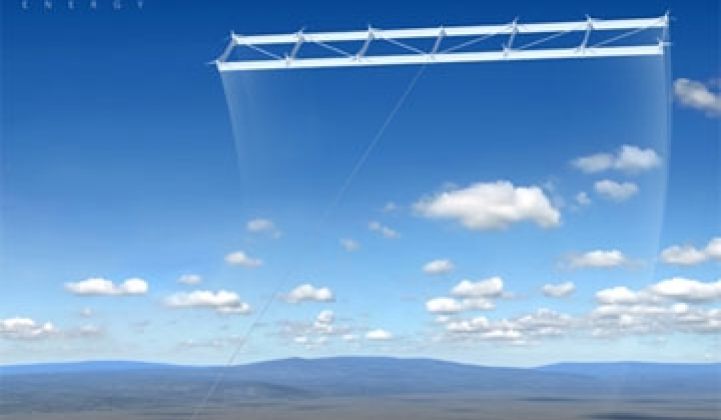It could slash the cost of wind power and greatly expand the size of the global footprint for wind.
And, no, airborne wind power advocates add, they aren't crazy.
Airborne wind power -- a concept based on devices that can harvest power from the upper layers of the atmosphere or even the jet stream-- remains largely in the conceptual stage, but progress is occurring. Companies like Makani Wind Power, Magenn Power and Joby Energy have built scaled-down models and have conducted a number of tests. Next year, Joby hopes to launch a 500-kilowatt multi-wing turbine.
If all goes well, the crawl toward commercialization within a decade or so could begin. The challenges involved in such a process promise to be hot topics at the Airborne Wind Energy Conference taking place at Stanford on September 28 and 29.
A major part of the attractiveness of airborne devices lies in raw materials, says Archan Padmanabhan, director of business development at Joby. A standard wind turbine requires a massive amount of steel, concrete, aluminum and other materials. In all, they average 96 tons of materials per megawatt.
"It looks like we can get down to 20 tons per megawatt," he said, which in turn could lead to capital costs of $1.20 per watt or less.
Airborne devices can also function well in a wide variety of geographies because terrestrial obstacles -- mountains, downtown clusters, etc. -- don't interfere nearly as much with the strong winds of the upper atmosphere or jet stream. Joeben Bevirt, Joby's CEO, has said that tropospheric winds hold as much as 870 terawatts of potential power. Once aloft, these devices would ideally be kept in the sky by the power of the wind or with batteries charged from the power harvested from the wind.
Yes, but what about the Skylab problem of debris falling from the sky? To address this challenge, Joby wants to build a winged structure arrayed with 14 propellers tethered to the earth with a cord, while Makani has envisioned a glider-like wing.
It's a huge concern. To that end, these companies are trying to fine-tune guidance and recovery systems that would permit an airborne craft to navigate a safe path back to Earth. Companies are also scrutinizing the dynamics of the tether and how the tether will behave in the different types of weather and atmospheric conditions it will experience. Air pressures and moisture content in the air will vary significantly along the length of the tether.
Like the wave and tidal companies, the airborne industry is so new that basic design standards don't exist. Magenn, for instance, is building a blimp that looks like a medical implant that has been turned into a Macy's Thanksgiving Day Parade float. Others more closely resemble kites.
The technology divides along six parameters. Will the craft be deployed one kilometer in the air, or higher, in the more rapidly flowing jet stream? (Right now, FAA rules and the current state of technology mean that the companies are clustering around the 1 kilometer opportunity). Next, is it a lighter-than-air aircraft like Magenn's or not? Third, is the power generated in the atmosphere, or does the generator sit on the ground?
While skepticism exists, interest is picking up, particularly in Europe and on island nations. Both the Department of Defense and ARPA-E (the R&D agency inside the Department of Energy) are examining various atmospheric concepts. Makani received some investment funds from Google, but it also experienced layoffs earlier this year.
Speakers at the Airborne Wind Energy Conference will include scientists from Europe and the U.S. national labs, as well as officials from the FAA.



